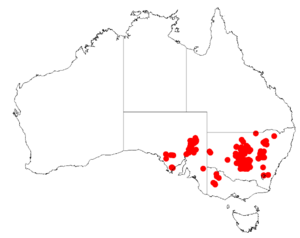Haviland's wattle facts for kids
Quick facts for kids Haviland's wattle |
|
|---|---|
| Scientific classification | |
| Genus: |
Acacia
|
| Species: |
havilandiorum
|
 |
|
| Occurrence data from AVH | |
Acacia havilandiorum, also known as Haviland's wattle or needle wattle, is a type of shrub. It belongs to the Acacia plant family. You can find this plant growing naturally in parts of South Australia, New South Wales, and Victoria.
What Does Haviland's Wattle Look Like?
This bushy shrub or small tree usually grows to be about 1.5 to 4 metres (5 to 13 ft) tall. Its branches are smooth and round. Like most Acacia plants, it has special leaf-like parts called phyllodes instead of true leaves.
These phyllodes are grey to green. They stand upright or slightly curved. They are also quite stiff and break easily. Each phyllode is about 3 to 9 cm (1.2 to 3.5 in) long and 0.8 to 1.5 mm (0.031 to 0.059 in) wide.
Haviland's wattle blooms between July and October. It produces simple flower clusters. These clusters grow in groups of one to three where a leaf joins the stem. Each cluster has round flower-heads. These flower-heads are 3 to 7.5 mm (0.12 to 0.30 in) wide. They contain 20 to 30 bright yellow flowers.
After the flowers, the plant grows smooth, papery seed pods. These pods are straight or slightly curved. They are raised over each seed and a little squeezed between them. The seed pods are 3 to 9 cm (1.2 to 3.5 in) long and 2 to 3 mm (0.079 to 0.118 in) wide.
How Did Haviland's Wattle Get Its Name?
The scientific name for this plant, havilandiorum, honors Edwin Haviland. He was a businessman from Sydney. Edwin Haviland was very interested in native Australian plants.
Where Does Haviland's Wattle Grow?
You can find Haviland's wattle in different places. Its growing areas are spread out and not continuous. It grows as far west as the Eyre Peninsula in South Australia. It is also common further north in the Flinders Ranges.
The plant's range extends through to Griffith and Cobar in New South Wales. It reaches as far east as Gilgandra. In Victoria, it is only known around Horsham in the north-west part of the state.
In New South Wales, this plant is mostly found in the Pilliga Scrub. This area is between Gilgandra and Milgee. It grows there as part of mallee and box woodland areas.

